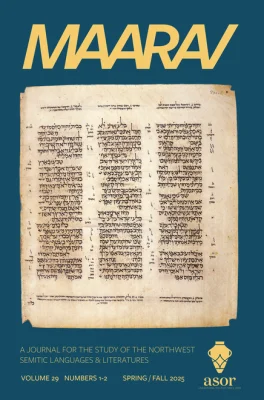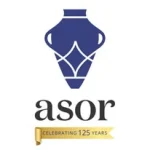
Table of Contents for Maarav 29.1-2 (2025)
Pp. 1-25: ““The Anger of the Queen Has Gone Forth”: Ilimilku’s Warning to Urtenu in a Ugaritic Piggyback Letter (RS 94.2406 [KTU3 2.88])” by Heath D. Dewrell
The present essay begins with a reexamination of a “piggyback” letter from Late Bronze Ugarit, RS 94.2406 (KTU3 2.88), offering a fresh edition of this letter from an unnamed queen of Ugarit to Urtenu that contains a second letter from a certain Ilimilku to the same appended to the end. The edition presented here notes a previously unacknowledged difficulty that, once recognized and accounted for, serves to reveal a degree of tension between the queen of Ugarit and Ilimilku, her scribe. Once properly understood, it becomes clear that Ilimilku’s piggyback letter at the very least recontextualizes the queen’s letter and may well even go so far as to contradict the queen’s instructions outright. The second portion of the essay embarks on a comparison with other analogous piggyback letters from the Late Bronze age, written in both Akkadian and Hittite, to reveal that Ilimilku’s piggyback letter is hardly unique in these regards and that it was not especially uncommon for scribes to append their own letters to those of their patrons, apparently without the latter’s knowledge, often with the goal of advancing the scribes’ own interests and agendas.
ASOR Members with online access: log into ASOR’s Online Portal here. Once logged in, click the JOURNALS tab in the top navigation bar. From here you may select which journal you would like to read. If you have online access, you will see your selected journal’s current issue Table of Contents. Click on the “Current Issue” button and you will then be redirected to the University of Chicago Press’s (UCP) platform to immediately start reading any issue of your choice. Tutorials for how to log in to the Online Portal as well as how to navigate to the Portal Journals page can be found here.
Pp. 27-119: “‘The Rise of “National” Scripts in the Iron Age II: A Proposal” by Nathaniel E. Greene and Jeremy M. Hutton
Northwest Semitic paleographic data has inspired a consensus that several “national” scripts had become well-established by the Iron IIB. Many treat these scripts as expressions of self-contained identity. Moreover, they are often framed in ways that gloss over aspects of scribal training. Questions remain, however, regarding the behavioral processes that affected such developments. To account for these processes, we propose a “franchise” model of scribal training: a few centers produced scribal lineages that, once established, operated semi-independently. While some scribes may have been held “on retainer,” most likely hired themselves out on a localized “freelance” system. The selection of national scripts was thus inadvertent and not motivated by exertions of “national” identity. Royal courts of the Iron Age IIB unintentionally adopted “micro-features” of the alphabetic script that had been formalized in the scribal lineage(s) prestigious enough to enjoy employment in major centers. Rather than serving as a distinctive marker of national consciousness imposed from the top-down, the development of “national scripts” was the natural effect of local patronage and “elite emulation” of micro-features by more peripheral scribes. The nationalization of scripts was therefore incidental to the emergent national consciousness and driven by individual scribes and the training regimens connecting them.
ASOR Members with online access: log into ASOR’s Online Portal here. Once logged in, click the JOURNALS tab in the top navigation bar. From here you may select which journal you would like to read. If you have online access, you will see your selected journal’s current issue Table of Contents. Click on the “Current Issue” button and you will then be redirected to the University of Chicago Press’s (UCP) platform to immediately start reading any issue of your choice. Tutorials for how to log in to the Online Portal as well as how to navigate to the Portal Journals page can be found here.
Pp. 121-178: “Conflate Readings and the Lamentations Textual Tradition” by F. W. Dobbs-Allsopp
One dimension of Lamentations’s textual tradition, namely, its propensity for conflate readings, provides the chief focus of inquiry in this essay. As I work to collect, elucidate, and clarify these conflate readings, other dimensions of these poems’ extant and reconstructable textualities come into view, viz. their rough chronology, prevalence of variability and multiformity. The phenomenon of conflate readings is well known to textual scholars of the Bible. The presenting peculiarity in Lamentations is the breakage in form to no apparent end that the preservation of such readings inevitably entails. Given how integral form is to this poetry’s operative poetics, such deformations require explanation. The solution posed posits shifts over time in the literary values that guided scribal practice when it came to the collecting and recording of variant readings. The resulting view of Lamentations’s literary history is far richer, more complex, and truer to scribal realia than that usually presumed by students of these poems.
ASOR Members with online access: log into ASOR’s Online Portal here. Once logged in, click the JOURNALS tab in the top navigation bar. From here you may select which journal you would like to read. If you have online access, you will see your selected journal’s current issue Table of Contents. Click on the “Current Issue” button and you will then be redirected to the University of Chicago Press’s (UCP) platform to immediately start reading any issue of your choice. Tutorials for how to log in to the Online Portal as well as how to navigate to the Portal Journals page can be found here.


